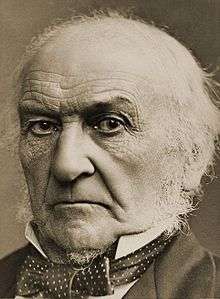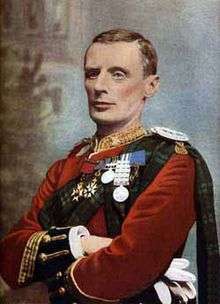Midlothian (UK Parliament constituency) (1708–1918)
| Edinburghshire | |
|---|---|
|
Former County constituency for the House of Commons | |
| 1708–1918 | |
| Number of members | One |
| Replaced by |
Midlothian & Peebles Northern Peebles & Southern |
| Created from | Edinburghshire |
Edinburghshire (also known as Midlothian) was a county constituency of the House of Commons of the Parliament of Great Britain (at Westminster) from 1708 to 1801 and of the Parliament of the United Kingdom (also at Westminster) from 1801 to 1918.
It elected one Member of Parliament (MP) by the first past the post system of election.
The seat is most famous as the location of William Ewart Gladstone's upset victory in the Midlothian Campaign of 1880, regarded as the birth of the modern political campaign in the United Kingdom. After Gladstone's victory it became the first non-English constituency to be represented by a serving prime minister.
Boundaries
As first used, in 1708 general election of the Parliament of Great Britain, the constituency covered the county of Edinburgh, except the burgh of Edinburgh, which was covered by the Edinburgh burgh constituency. 1708 boundaries were used also for all subsequent elections of that parliament.
In 1801 the Parliament of Ireland was merged with the Parliament of Great Britain to form the Parliament of the United Kingdom . The first general election of the new parliament was the general election of 1802. There was no change to the boundaries of any pre-existing Westminster constituency, and 1802 boundaries were used also in the general elections of 1806, 1807, 1812, 1818, 1820, 1826, 1830 and 1831.
For the 1832 general election, as a result of the Representation of the People Act 1832, the constituency was redefined. The boundaries of counties and burghs for parliamentary purposes ceased to be necessarily those for other purposes, but nominally the Edinburghshire constituency consisted of the county of Edinburgh minus the burghs of Edinburgh, Leith, Portobello, and Musselburgh. Edinburgh was again covered by the Edinburgh constituency, and Leith, Portobello and Musselburgh were covered by the Leith Burghs constituency.
1832 boundaries were used also in the general elections of 1835, 1837, 1841, 1847, 1852, 1857, 1859, 1865, 1874, 1880, 1886, 1892, 1895, 1900, 1906, January 1910 and December 1910.
For the 1918 general election, as a result of the Representation of the People Act 1918, the area of the Edinburghshire constituency was mostly divided between the Midlothian and Peebles Northern and Peebles and Southern Midlothian constituencies. By this date, the county of Edinburgh had been renamed as the county of Midlothian.
The Midlothian and Peebles Northern constituency consisted of the Calder and Suburban districts and part of the Lasswade district of the county of Midlothian, and the Peebles and Southern constituency consisted of the county of Peebles, the Gala Water district and part of the Lasswade district of county of Midlothian, and the burghs of Bonnyrigg, Lasswade, and Penicuik in county of Midlothian.[1]
The rest of the county of Midlothian was covered by the Edinburgh Central, Edinburgh East, Edinburgh North, Edinburgh South, Edinburgh West and Leith constituencies.[1]
Member of Parliament
| Election | Member | Party | |
|---|---|---|---|
| 1708 | George Lockhart | Tory | |
| 1715 | John Baird | ||
| 1722 | Robert Dundas | ||
| 1737 | Sir Charles Gilmour | ||
| 1751 | Robert Balfour-Ramsay | ||
| 1754 | Robert Dundas | Whig | |
| 1761 | Sir Alexander Gilmour | ||
| 1774 | Henry Dundas | Tory | |
| 1790 | Robert Dundas | Tory | |
| 1801 | Robert Saunders-Dundas | Tory | |
| 1811 | Sir George Clerk, Bt | Tory | |
| 1832 | Sir John Dalrymple, Bt | Whig | |
| 1835 | Sir George Clerk, Bt | Conservative | |
| 1837 | William Gibson Craig | Whig | |
| 1841 | William Ramsay Ramsay | Conservative | |
| 1845 | Sir John Hope, Bt. | Conservative | |
| 1853 | The Earl of Dalkeith | Conservative | |
| 1868 | Sir Alexander Ramsay-Gibson-Maitland | Liberal | |
| 1874 | The Earl of Dalkeith | Conservative | |
| 1880 | William Ewart Gladstone | Liberal | |
| 1895 | Sir Thomas Gibson-Carmichael | Liberal | |
| 1900 | The Master of Elibank | Liberal | |
| 1906 | Lord Dalmeny | Liberal | |
| 1910 | The Master of Elibank | Liberal | |
| 1912 | John Augustus Hope | Unionist | |
| 1918 | constituency abolished | ||
Election results
1860s
| Party | Candidate | Votes | % | ± | |
|---|---|---|---|---|---|
| Liberal | Alexander Ramsay-Gibson-Maitland | 1,195 | |||
| Conservative | Earl of Dalkeith | 640 | |||
| Majority | |||||
| Turnout | |||||
| Liberal hold | Swing | ||||
1880s

| Party | Candidate | Votes | % | ± | |
|---|---|---|---|---|---|
| Liberal | Rt Hon. William Ewart Gladstone | 7,879 | |||
| Conservative | Charles Dalrymple | 3,248 | |||
| Majority | |||||
| Turnout | |||||
| Liberal hold | Swing | ||||
At a by-election in February 1886, Gladstone having accepted office as Prime Minister, he was returned unopposed.[3] General Election 1886: William Ewart Gladstone elected unopposed.[3]
1890s

| Party | Candidate | Votes | % | ± | |
|---|---|---|---|---|---|
| Liberal | Rt Hon. William Ewart Gladstone | 5,845 | |||
| Conservative | Andrew Gilbert Wauchope | 5,155 | |||
| Majority | |||||
| Turnout | |||||
| Liberal hold | Swing | ||||
At a by-election on 23 August 1892, William Gladstone was returned unopposed.[4]

| Party | Candidate | Votes | % | ± | |
|---|---|---|---|---|---|
| Liberal | Sir Thomas Gibson-Carmichael | 6,090 | |||
| Conservative | North de Coigny Dalrymple-Hamilton | 5,631 | |||
| Majority | |||||
| Turnout | |||||
| Liberal hold | Swing | ||||
1900s
| Party | Candidate | Votes | % | ± | |
|---|---|---|---|---|---|
| Liberal | The Master of Elibank | 5,804 | |||
| Conservative | North de Coigny Dalrymple-Hamilton | 5,490 | |||
| Majority | |||||
| Turnout | |||||
| Liberal hold | Swing | ||||
| Party | Candidate | Votes | % | ± | |
|---|---|---|---|---|---|
| Liberal | Lord Dalmeny | 8,348 | |||
| Conservative | Frank J. Usher | 5,131 | |||
| Majority | |||||
| Turnout | |||||
| Liberal hold | Swing | ||||
1910s

| Party | Candidate | Votes | % | ± | |
|---|---|---|---|---|---|
| Liberal | Master of Elibank | 9,062 | |||
| Conservative | Mountstuart William Buller-Fullerton-Elphinstone | 5,427 | |||
| Majority | |||||
| Turnout | |||||
| Liberal hold | Swing | ||||
| Party | Candidate | Votes | % | ± | |
|---|---|---|---|---|---|
| Liberal | Rt Hon. Master of Elibank | 8,837 | 60.9 | ||
| Conservative | John Augustus Hope | 5,680 | 39.1 | ||
| Majority | 21.8 | ||||
| Turnout | |||||
| Liberal hold | Swing | ||||

| Party | Candidate | Votes | % | ± | |
|---|---|---|---|---|---|
| Unionist | John Augustus Hope | 6,021 | 41.7 | ||
| Liberal | Alexander Shaw | 5,989 | 41.5 | ||
| Labour | Robert Brown | 2,413 | 16.7 | ||
| Majority | |||||
| Turnout | |||||
| Unionist gain from Liberal | Swing | ||||
Notes and references
- 1 2 Boundaries of Parliamentary Constituencies 1885-1972 (ISBN 0-900178-09-4), F. W. S. Craig, 1972
- ↑ Debrett's House of Commons and the Judicial Bench, 1870
- 1 2 3 Debrett's House of Commons and the Judicial Bench, 1889
- 1 2 Whitaker's Almanack, 1893
- 1 2 Debrett's House of Commons and the Judicial Bench, 1901
- ↑ Whitaker's Almanack, 1907
- 1 2 3 Debrett's House of Commons and the Judicial Bench, 1916
Leigh Rayment's Historical List of MPs – Constituencies beginning with "M" (part 2)
| Parliament of the United Kingdom | ||
|---|---|---|
| Preceded by Buckinghamshire in 1876 |
Constituency represented by the Prime Minister 1880–1885 1886–1886 1892–1895 |
Succeeded by Manchester East in 1902 |